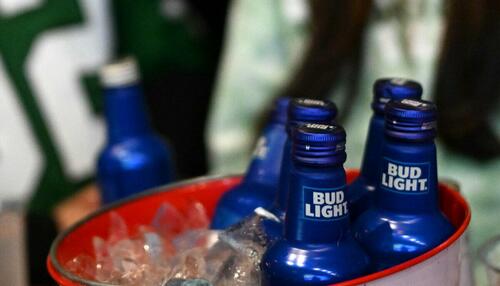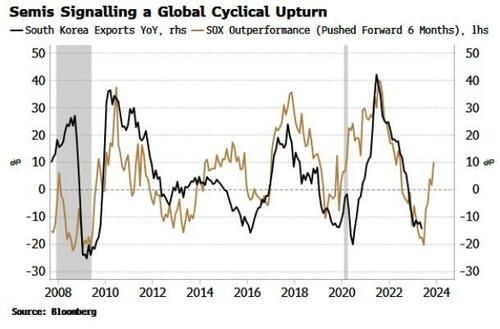Authored by MN Gordon via EconomicPrism.com,
Much of legislative activity is grossly overcomplicated. This is because honest governance is missing from the process.

The simple and honest way to put headspace between the debt and the debt ceiling is to run a budget surplus and use the excess to pay down the debt. The politics of the moment make this impossible.
Unless something radical happens, the Senate will soon pass the debt ceiling bill. Perhaps by the time you read this, it has already happened. Are you happy?
You shouldn’t be. Not if you believe in small, limited government, greater freedom and autonomy, and future prosperity for your kids and grandkids. If you believe in these things, then raising the debt ceiling is a direct assault on your sensibilities and way of life.
Alas, most Americans don’t give a rip that the debt ceiling was raised. They’re too busy running up their own consumer debt to care what Washington’s doing. And like the federal government, when they run out of money, and max out their credit cards, they borrow more. For tomorrow never comes.
Without question, U.S. consumers have buried themselves under a huge mountain of debt. The latest report from the New York Federal Reserve shows that total household debt has eclipsed $17 trillion for the first time ever.
Of this, $12.04 trillion is mortgage debt, followed by $1.60 trillion in student debt, $1.56 trillion in auto debt, and about $1 trillion in credit card debt. Other debt, at $510 billion, and home equity line of credit, at $340 billion, round out the debt pile.
This $17 trillion achievement has been attained at a time when the personal savings rate is just 4.6 percent. This is almost half of the 8.9 percent personal savings rate averaged over the last decade. What’s going on?
Are Americans trying to keep up with the Joneses? Are they just trying to pay their bills? Or has a deeper psychological shift occurred?
Currency Destruction
Americans have suffered the highest wave of consumer price inflation in 40 years. Are they spending money with the sole intent of getting rid of it before it becomes worth less and less?
Currently, we don’t think the American psyche has been damaged to this extent. Consumers are more likely spending their savings and running up debt in an attempt to maintain inflated living standards.
Yet further bungling of Fed monetary policy could motivate people to accelerate their spending. At this very moment, the economic stars appear to be aligning in a way that could compel Fed Chair Powell to do something dumb.
Specifically, in Q4 of this year, it’s very likely that reported gross domestic product (GDP) will show a contraction for two consecutive quarters. Politicians never want to head into an election year with the economy in a recession.
Thus, by late-fall, numbskulls like Elizabeth Warren and Bernie Sanders will be screaming for the Fed to do something. To slash interest rates and buy Treasury bonds.
But what if the consumer price index is still above 4 percent – double the Fed’s preferred target? Will the Fed acquiesce to the politicians?
What then? Does another wave of raging consumer price inflation then wash ashore? Do consumers then start dumping their dollars in earnest?
These are the sorts of dreadful questions that must be asked in a world with fiat currency and politicized monetary policy.
In the interim, American consumers have dug themselves into a deep hole. The pathway way out involves saving money and paying down debt.
Yet elevated consumer prices make this especially difficult. Moreover, there’s little incentive to save money when it’s in a currency that’s being systematically destroyed.
Price Deflation
Remember, getting consumers to spend by debasing the currency was the intention of monetary policy all along. The way the government policy makers view it, saving money is bad for the economy.
Their short-sighted logic is that saving money means less spending. And less spending, in an economy where consumer spending accounts for over 70 percent of GDP, could lead to deflation.
Deflation, in essence, means a general reduction of prices. As opposed to inflation, deflation allows consumers to buy more goods or services tomorrow with the same money they have today. Savvy consumers will then delay purchases in anticipation they can buy more for less in the future.
For example, if you’re in the market for a new car, now may be a good time to delay your purchase. A recent report from UBS estimates that there’s an excess of 5 million vehicles that will require price cuts before they are sold. We knew $1,000 per month car payments wouldn’t last.
With respect to the cycle of deflation, lower spending leads to less income for businesses and producers. This, in turn, leads to less production, worker pink slips, higher unemployment, and GDP contraction.
The real damage from deflation, however, is to leveraged businesses and individuals. As asset prices deflate, along with profits and incomes, the ability to service existing debt becomes harder and harder. Eventually, mass bankruptcies occur.
This is problematic for lenders and bankers and can push them to insolvency. Ultimately, it can lead to a financial crisis, breakdown in the credit market, and an economic recession or depression.
On the Importance of Deflation and Depressions
This all sounds rather grim. And it is. But, nonetheless, it doesn’t mean deflation should be ignored or avoided.
Deflation and depressions, like colon polyps, are a part of life. And should be faced with dignity and grace.
Moreover, after an extreme episode of government sponsored inflation, deflation and an economic depression are precisely what are needed to bring prices, incomes, supply and demand, and wants and needs, back into balance.
Perpetually attempting to forestall deflation and depressions by pumping credit and piling up debt has erected an economy that is totally unworkable for hard-working families. Moreover, it has completely obliterated the middle class.
Politicians may not like deflation, as it increases the odds that they’ll lose their cushy jobs. Still, just about every family out there could use some relief on their weekly grocery bill. This relief would be better delivered by deflation rather than issuing more and more EBT cards.
Similarly, after a decade of asset price inflation, prospective first-time home buyers would benefit from house price deflation. Not only would houses be more affordable. House prices that are more in line with incomes would free up more cash for savings, investments, and wealth building.
It’s difficult to get ahead when half of your after-tax income is going to pay the mortgage. Deflation would make this possible. What’s more, deflation would also make penny candy possible again.
The point is the policy makers got it all wrong. Spending money to juice GDP growth does not lead to greater societal wealth. It leads to inflation, price distortions, supply gluts, wealth disparities, and over indebted consumers and businesses.
Real wealth – for individuals, businesses, and the economy as a whole – comes from capital formation. And capital formation starts with spending less than you make and saving the difference.
The savings can then be invested in new businesses or in existing profit-generating businesses. This is how wealth is created.
Unfortunately, an episode of deflation would result in a lot of good people losing their jobs. We don’t like it. But over time this would free people up to pursue more useful endeavors.
In closing, price deflation and an economic depression are needed to restore the economy to a place where people can get on with the business of improving their lives through incremental capital formation. So long as they have a stable currency, political freedom, and the discipline to do it.
* * *
Like this article? If so, please Subscribe to the Economic Prism.








